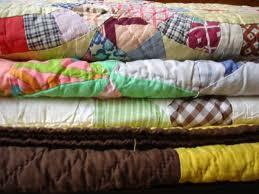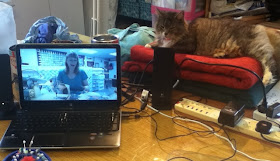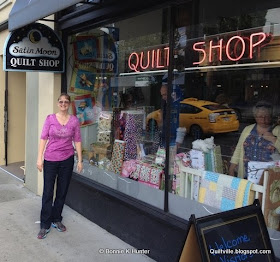Every once in a while an email comes in with a question that would really make a great topic for a blog post.
This is a question I’ve had to answer many times from readers, and I think if I put the answer here, in the archives that it would be a good place to refer folks, rather than my having to write it out time and time again as the need arises, as it does quite often.
This email is from Judy, and she writes:
Bonnie,
I am a faithful follower of your Quiltville blog and enjoy it very much.
I have a question regarding old quilts. I have quilts made by my husbands mother who passed at the age of 97. She would have been 100 years old this year had she lived. The quilts I have are VERY old and were made, according to her, before she married in 1940, by her, her mother and/or her sisters.
My question is how to handle these quilts. Fabric in some of them seems very fragile and binding is worn or frayed, but centers appear to be okay. The fabric on some of the quilts is worn and torn and appear to be beyond repair. We talked about quilt making through the years, but I did not become an active quilter until about 10 years ago and by that time she was in a nursing home and memory was slipping badly. She did indicate to me that they used cotton from the field as batting for their quilts as she was raised on a farm in AL and made do with what they had. These are rough country quilts, pieced by hand and quilting is not fancy. Once she married and moved to the “big city of Birmingham” she never quilted again.
It seems a shame to leave these quilts stored in trunks, which has been the case up to now. I am not sure how to clean these quilts or display them (they do not appear stained or dirty). I have no expertise in the history of fabrics and frankly they look more like utilitarian quilts; I’m sure some of the fabrics were feed sacks; backs are pieced and multiple fabrics used for backs, but the front of the quilts appear to be patterns that appeared in newspapers. I guess I would like to display some of the “better” quilts. I do not want to use them as bed quilts as I think they are too fragile for that kind of use. To my knowledge she never used these quilts on the beds in her home, as I don’t remember ever seeing them when we visited in Birmingham. However, I would like to honor my mother-in-law by displaying some some of her work.
We now live in Raleigh, NC (transplants from IL) and I found your blog after moving here. I know you have an interest in old quilts and while I know these have no great monetary (only sentimental) value, I hoped you could give me some advice on how to take care of them.
Thanks in advance,
Judy F
If your quilt already has damage, washing can enlarge holes, bunch up batting and cause further deterioration of the fabric, so only you can choose whether it is best to actually wash a quilt, or to leave it as is, folded to display the best parts as show-pieces. I recommend mending BEFORE washing.
That said, I feel perfectly fine machine washing sturdy utilitarian quilts that were made past 1940, including my own quilts in my front loading washer on the hand wash cycle. Quilts older than that must be hand washed, if washed at all.
How I handle really old vintage quilts and textiles:
Vintage quilts require special care during cleaning. Do not dry clean or machine wash an heirloom piece. Dry cleaning chemicals can permanently harm old fabrics and the agitation action of a washing machine can cause fibers to shred or disintegrate
.
If your quilt is musty, try airing your quilt outside on a sunny day to restore freshness. To remove dust, vacuum with a nylon stocking over the end of vacuum hose and hold the hose slightly above the top of the quilt. You can also place a layer of window screen on top of the quilt, and vacuum through the screen.
If you feel that you quilt must be washed, begin by checking the fabric for colorfastness. Testing is simple, wet a piece of white cloth with cold water and gently rub it over each different color or fabric in your quilt. If there is any color transfer to the white cloth, don’t wash your quilt at all. Washing will result in discoloration, bleeding and/or fading.
To hand-wash, fill a deep, laundry sink or bathtub with cold water. Be certain that the sink or tub is very clean and has no residue from cleaning agents that could cause damage to the quilt. Use a liquid detergent that is gentle and free of dyes and perfumes. I like to use Orvus Soap, a paste found in feed stores and used for washing livestock.
Place your quilt in the water, being certain that the entire quilt gets wet. Gently move your quilt around in the water. Allow the quilt to remain in the water for about 10 minutes. Next, drain the wash water and fill the tub again with fresh water. Repeat draining and refilling the tub until the water and quilt are soap free – clear water and no suds.
You may add 1/2 cup vinegar to the rise water to both brighten colors, remove odors and soften the quilt.
Proper drying is also important in keeping your quilt at its best. Wet quilts must be handled gently. Pulling or wringing can break seams and cause damage. The quilt will be heavy and should be dried flat. To lift the quilt from the tub, use a white sheet to create a sling. Allow the excess water to drain than place the quilt on a bed of heavy towels. Cover with more towels and roll up to absorb water. Move the quilt to another bed of dry towels, spread out flat and allow to dry. Placing a fan in the room will help to speed the process.
If you have space, place a sheet on the grass outside and spread out the quilt. Cover the quilt with another clean sheet and allow to dry. Do not dry in direct sunlight, which can cause fading, without the top sheet in place. Never suspend a wet quilt from a clothesline. This causes too much stress on seams and cause tearing and can displace batting.
I know it sounds like a lot of work, and it is.
There is a lot of discussion going on about using things like Oxi-Clean for stain removal, and the jury is out on that one for me. I don’t want to do anything that is going to damage the fibers of the fabric any further, but some say that you can remove most stains by mixing a solution of OxiClean, Clorox 2 or Purex Color Safe Bleach and cool water. Follow the package directions as to how much product per gallon of water. Completely submerge the quilt in the solution and allow it to soak for at least eight hours. Check the stain. If it is gone, rinse well and dry. If it remains, mix a fresh solution and repeat. It may take several soakings to remove the stain but it should come out. Do this at your own risk. I have not tried this myself --- yet. Fear has got the best of me!
I know we are a wild world of quilting knowledge, and I would love it if you can add your comments and advice in the comments section below. I plan to list this page in my tips & techniques tab for future reference for everyone – so please share!
This afternoon we are cabin bound! Hard to believe it is Labor Day weekend already ----
If I can get to it today, I’ve got a bunch of things I want to list for a Labor Day Yard Sale of quilt items. Yes, I know it’s last minute…..but I’ll put up a linky if anyone else is interested in clearing out some sewing stuff? Leave me a comment and let me know and if there is enough interest, we will run a Labor Day Yard Sale!
 Click Here to like our Quiltville Friends Page on Facebook for more fun!
Click Here to like our Quiltville Friends Page on Facebook for more fun!




















































